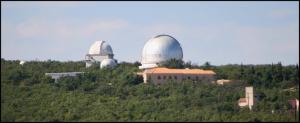Saint-Michel-l'Observatoire: an exoplanet is born
The sky of Haute-Provence has always been one of the purest, driest and most transparent in Europe. The area around Manosque and Forcalquier enjoys an average of 300 cloudless days a year—and about as many clear nights—which, besides making life very pleasant, is ideal for astronomical observations.
It was even more so in the late 1920s, when the French National Service for Scientific Research decided to create a new observatory to complement the one in Paris, where fog, urban lights and ground vibrations were making observations more and more difficult.
Site studies lasted for several years and in 1936, a wooded plateau close to the village of Saint-Michel, 12 km to the south-east of Forcalquier, was eventually chosen to host the installation.
For more than a half-century, by observing stars and comets, galaxies and asteroids the Observatoire de Haute-Provence (OHP) was to contribute to the understanding of the Universe.
But in the world of astronomy things were changing fast: new challenges required more powerful instruments, which, in turn, demanded ever more transparent skies and a stable atmosphere. Eight- or ten-metre mirrors were becoming the norm, positioned at ever higher altitudes. With its 1.93-metre telescope, peering at the stars from a hilltop a mere 600 metres high, the OHP, once among the leading observatories in Europe, was under threat.
By the mid 1990s, the place was scheduled to close. At this point, two astronomers from Observatoire de Genève, Switzerland, using a high performance spectrometer coupled to the old "193," made an historical discovery: a planet orbiting a distant star 48 light-years from Earth—the first proof that the solar system was not unique in the Universe.
The discovery of this "hot Jupiter" orbiting star 51 Pegasi was to be followed by scores of others. Searching for exoplanets is now one of the observatory's fields of excellence: more than 300 have been discovered to this day, some 30 of them at the OHP.
Needless to say, no one talks about closing the old Provencal observatory anymore.



